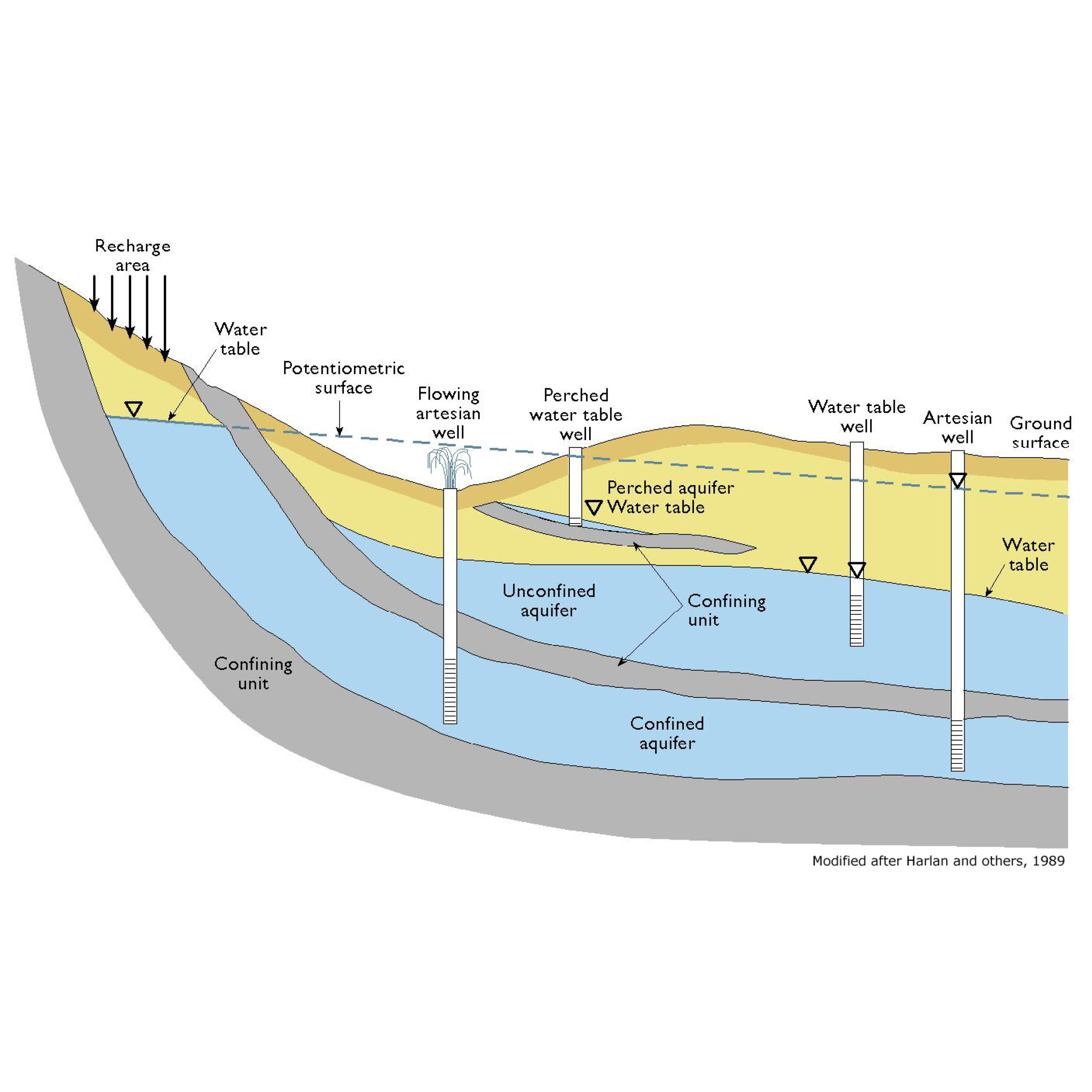
First a water source needs to be found and then it can be extracted through countless mechanisms. This can be at small or large scales even with the same techniques such as accessing aquifers through wells and pumps by individual households in Jakarta or the Mexico City Water System Wells (SACM). In general this is in order to access drinking water although it can be done for irrigation uses.
Springs are readily accessible sources of water, but Water Mains are established when the source is not yet flowing or flowing in another direction. In the case of Mexico City, the drinkable water of the Endorheic Basin there largely begins at the Sierra Chichinautzin due to the large amount of basalt rock that allows for the water to enter the ground and begin its filtration process. At the other end the Xochimilco springs is an important site for the basin and many of the most productive wells are located here. Some of these make up the 549 wells in the SACM which are also supplemented by the Lerma System wells that bring in water from past the Sierra Madre Occidental from other valleys.
Even further than that the Cutzamala System, taps the Cutzamala River that is part of the Balsas Basin and moves it 60-154km horizontally and over 1000m vertically to bring it to the Valley of Mexico while tapping numerous other sources on the way. The system was initially developed in 1930 as a hydropower project called the Miguel Aleman Hydroelectric System but then it was adapted to the Cutzamala System and 102 pumping stations, 17 tunnels, and 7.5km of canals were planned. Due to the massive scale of this project it was executed in three stages. Now it has eight main reservoirs, six main pumping plants, 322km of canals and tunnels, a water treatment plant, and eight dams. This massively expensive and energy-intensive project has reduced the burden of providing drinking water from the Mexico and Lerma Valley Aquifers and still is the primary focus in infrastructural investments. In 1997, the fourth stage of the project called the Temascaltepec project was to be initiated and was stopped as of now due to the local populations worries about the effects of a tunnel on the springs in the region.
← Back to Lexicon
Aquifer recharged and accessed by different types of wells
Sources: https://cnx.org/resources/91be4f9a9a78064d99ab3028c8c0be2806433e3f/graphics12.jpg
Sources: https://cnx.org/resources/91be4f9a9a78064d99ab3028c8c0be2806433e3f/graphics12.jpg
- National Research Council. 1995. Mexico City's Water Supply: Improving the Outlook for Sustainability. Washington, DC: The National Academies Press. https://doi.org/10.17226/4937.
- Martinez, S., Escolero, O. & Perevochtchikova, M. A comprehensive approach for the assessment of shared aquifers: the case of Mexico City. Sustain. Water Resour. Manag. 1, 111–123 (2015). https://doi.org/10.1007/s40899-015-0010

The Romans, with their appreciation for the spa and their aptitude for hydro-engineering were the first to connect Vienna via aqueducts to the Alpine springs and their mineral rich water. By the middle ages the city had regressed, sourcing its water from the Danube and from wells, the wells drawing from aquifers also fed by the river. However this river, a drain of nations, brought with it disease and by the 19thC even the dirty water was in short supply.
The first pipeline of the Hochquellenwasserleitung (HQL) was completed in 1873 and is nearly 90 km long. It was created with a 19thC pride for civil engineering, built “in the style of Adam; namely, naked and strong”. The system requires no mechanical pumping, gravity driving the water to the city. Tunnels and aqueducts traverse the hills and valleys that lie in the way. The system runs so well, that energy must be removed from the system to reduce the pressure.
A second pipeline was added in 1910, doubling capacity. Vienna can now provide up to 589,000 m³ daily, with an average consumption of around 375,000 m³. The majority of their water sourced from the two pipelines. The excess capacity is important to allow for peaks in consumption, and to give room for failure or planned maintenance. The first pipeline suffered major damage in 1945, when bombing led to a large amount of gravel entering the system, damaging pipes and slowing water flow. Repairs to remove the gravel took several years.
Pipelines allow cities to grow beyond the natural limits imposed by their water supply. Water is sourced from aquifers and rivers, and in some cases transported over thousands of kilometers. From Tripoli to Los Angeles, cities slurp their water with these long straws. Whilst some supplies, such as the Alpine springs, are abundant, in other locations the piping of water comes at a cost. Former farming communities in California have lost their ability to grow, their water taken by Los Angeles, The 1400 km long Colorado River runs dry by the time it reaches the Mexican border. The Colorado river is entirely used to supply cities such as Las Vegas and for agricultural irrigation. Pipelines can result in cities drinking the surroundings dry, damaging environments far beyond the municipal borders.
← Back to Lexicon
1st Wiener Hochquellenleitung Section
Sources: Vienna at the beginning of the XX. Century - A guide in the technical and artistic direction (Vol.1)

The plumbing system reaches its widespread use during the ancient Rome period, which saw the introduction of an expansive system of aqueducts, wastewater removal, and widespread use of lead pipes. Romans built a water channel that carried water from the mountain into the city, which was distributed through an underground supply line made of lead. This is where the term plumbing originated as “Plumbus” in Latin mean lead.
The danger of lead poisoning was already being reported as early as 14 B.C by the Roman architect, Vitruvius. Later, similar cases of lead poisoning were being reported through time from Europe and the US. However, even with the danger of lead becoming increasingly obvious, the warning signs continued to be ignored.
In 1920 many cities and towns in the US were prohibiting or restricting the use of lead material, but an organization called LIA (Lead Industry Association) managed to carry out an effective campaign to prolonged and promoted the use of lead-based material for paint, plumbing, and gas. This movement also supported by the professional plumbers because the installation of lead fixture and pipes required expertise that other did not possess. To maintain the sales of lead material, the LIA lobbied the government at all levels and targeted the people who both designed and installed water distribution systems with educational material and other resources at least until the 1970s.
Today, even after lead being banned, the leftover lead still presents in our environment, the poison still lingers in our soil, dust and chipped from deteriorating house paint and lead-soldered pipes of an aging house. There are strategies to mitigate these exposure risks in the short term such as internal corrosion control, flushing, and filtering; but the only long-term solution is to replace all the lead pipe with other alternative materials such as copper, PVP, CPVC, or PEX pipes.
← Back to Lexicon
Redraw of Sources of Lead in Drinking Water
Sources: EPA. Source of Lead in Drinking Water. PDF File. May 2, 2021.
Sources: EPA. Source of Lead in Drinking Water. PDF File. May 2, 2021.
- Sohn, Emily. Lead: Versatile Metal, Long Legacy. Dartmouth. Accessed May 2, 2021. https://sites.dartmouth.edu/toxmetal/more-metals/lead-versatile-metal-long-legacy/.
- Lead Service Line. Wikipedia. Wikimedia Foundation, May 2, 2021. https://en.wikipedia.org/wiki/Lead_service_line.
- Plumbing. Wikipedia. Wikimedia Foundation, April 20, 2021. https://en.wikipedia.org/wiki/Plumbing.
- Rabin, Richard. “The Lead Industry and Lead Water Pipes “A MODEST CAMPAIGN.” American Journal of Public Health 98, no. 9 (2008): 1584–92.

30 - 103 AD
Roman hydraulic engineer, politician and author of technical treatises
Sextus Julius Frontinus was appointed the title “Curator Aquarum”, a position in Ancient Rome in order to administer the aqueduct system. He can be referred to as he Vitruvius of the plumbers, since he is the author of the first known technical treatise. He wrote De aquaeductu urbis Romae, a milestone in two volumes on Roman aqueducts providing valuable information, the first official report of an investigation about engineering works ever to have been published.
Below is an example of his description on Ajutage quinaria, a tube through which water is discharged; an efflux tube; as, the ajutage of a fountain.
“Those who refer it to Vitruvius and the plumbers, declare that it was so named from the fact that a flat sheet of lead 5 digits wide, made up into a round pipe, forms this ajutage. But this is indefinite, because the plate, when made up into a round shape, will be extended on the exterior surface and contracted on the interior surface. The most probable explanation is that the quinaria received its name from having a diameter of 5⁄4 of a digit, a standard which holds in the following ajutages also up to the 20‑pipe, the diameter of each pipe increasing by the addition of ¼ of a digit. For example the 6‑pipe is six quarters in diameter, a 7‑pipe seven quarters, and so on by a uniform increase up to a 20‑pipe.”1
← Back to Lexicon
Roman Aqueduct index of sections. Drawings by Ioannis Poleni.
Sources: https://www.dmg-lib.org/dmglib/streambook/index.jsp?bookid=23059009

The Viennese drinking water authority had a problem with their pipelines. They had designed them to work using the power of gravity over their hundreds of kilometers of pipework. The water would run freely from the high mountain springs, through tunnels and across aqueducts to the city. However due to the reduction in elevation the water pressure was too high; energy needed to be removed from the water. The solution was to use the drinking water to power small scale hydro electric power stations, named Trinkwasserkraftwerk in German.
Vienna Water now runs 12 power stations, generating enough electricity to power 20,000 homes whilst solving the problem of excessive water pressure in the system. The remote settlement of Hinternaßwald marks the end of 10 km of tunnels that connected to the seven springs of the Karlgrabenquelle that would often produce 300 l of water per second. At the end of these tunnels they joined the second Wiener Hochquellenleitung. Due to the 80m drop in elevation over the course of the tunnel and the resulting velocity of the water within it, a power station was built in 1951 to reduce the pressure. Because of Hinternaßwald ‘s remoteness it had not been connected to the Austrian national grid, and to this day their only power comes from the Trinkwasserkraftwerk.
← Back to Lexicon
The control interface of the small scale drinking water hydro-electric plant
Sources: R-S-Group
Sources: R-S-Group